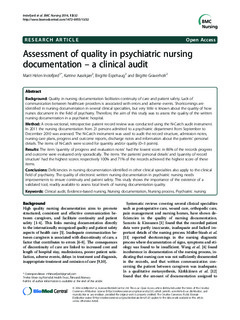Assessment of quality in psychiatric nursing documentation – a clinical audit.
Peer reviewed, Journal article
Permanent lenke
http://hdl.handle.net/11250/2481878Utgivelsesdato
2014Metadata
Vis full innførselSamlinger
Sammendrag
Background: Quality in nursing documentation facilitates continuity of care and patient safety. Lack of communication between healthcare providers is associated with errors and adverse events. Shortcomings are identified in nursing documentation in several clinical specialties, but very little is known about the quality of how nurses document in the field of psychiatry. Therefore, the aim of this study was to assess the quality of the written nursing documentation in a psychiatric hospital. Method: A cross-sectional, retrospective patient record review was conducted using the N-Catch audit instrument. In 2011 the nursing documentation from 21 persons admitted to a psychiatric department from September to December 2010 was assessed. The N-Catch instrument was used to audit the record structure, admission notes, nursing care plans, progress and outcome reports, discharge notes and information about the patients’ personal details. The items of N-Catch were scored for quantity and/or quality (0–3 points). Results: The item ‘quantity of progress and evaluation notes’ had the lowest score: in 86% of the records progress and outcome were evaluated only sporadically. The items ‘the patients’ personal details’ and ‘quantity of record structure’ had the highest scores: respectively 100% and 71% of the records achieved the highest score of these items. Conclusions: Deficiencies in nursing documentation identified in other clinical specialties also apply to the clinical field of psychiatry. The quality of electronic written nursing documentation in psychiatric nursing needs improvements to ensure continuity and patient safety. This study shows the importance of the existence of a validated tool, readily available to assess local levels of nursing documentation quality.
